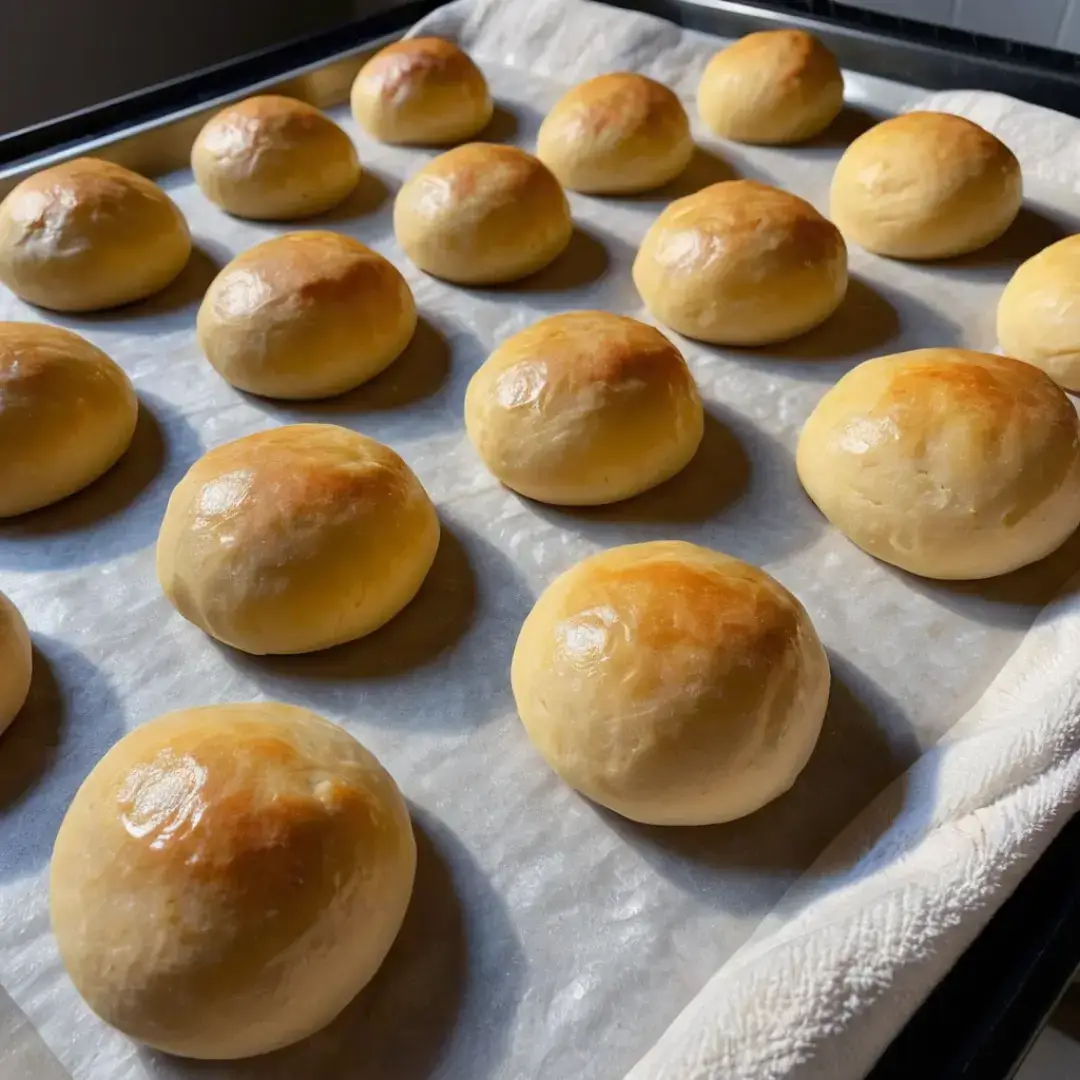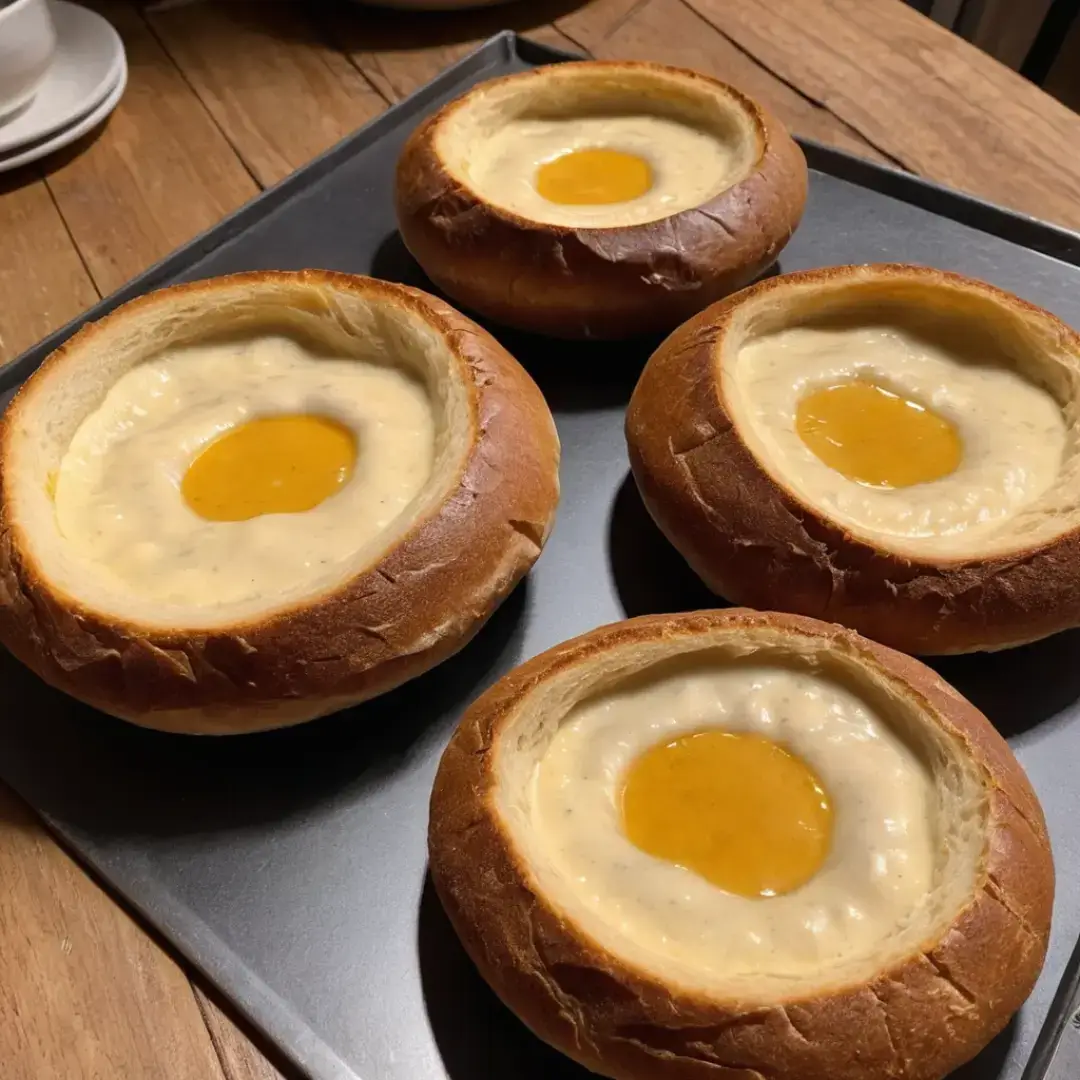Few things in life are as comforting as a warm bowl of soup, but what if you could take that experience to the next level? Enter Sourdough Bread Bowls—crispy on the outside, soft and chewy on the inside, and perfect for holding your favorite soups, chowders, or dips. These homemade bowls bring a rustic, bakery-style touch to your table while adding an extra layer of deliciousness to every bite.
Whether you’re making a cozy weeknight dinner, impressing guests, or simply enjoying the art of bread baking, these Sourdough Bread Bowls will elevate your meal. Plus, they’re easier to make than you think—let’s dive in!
Why You’ll Love This Recipe
There’s something truly special about homemade Sourdough Bread Bowls—they’re not just a vessel for soup, they’re part of the experience! The crisp, golden crust holds up beautifully against hot, creamy soups, while the chewy, tangy interior soaks up every last drop of flavor.
Miranda, the heart behind Milestone Recipes, believes that food should be both delicious and approachable. That’s why this recipe is designed to be simple enough for beginners but rewarding enough for seasoned bakers. Whether you’re filling these Sourdough Bread Bowls with chowder, chili, or creamy tomato soup, they bring warmth and comfort to every meal!
Ingredients for the Perfect Sourdough Bread Bowls
Making Sourdough Bread Bowls from scratch may sound intimidating, but with the right ingredients, it’s easier than you think! Each component plays a crucial role in achieving that crispy crust, chewy interior, and tangy sourdough flavor.
For the Sourdough Starter:
½ cup active sourdough starter (fed and bubbly)
1 cup warm water (around 75°F)
For the Dough:
4 cups bread flour (plus extra for dusting)
1 ½ teaspoons salt
1 cup warm water
½ cup sourdough starter (from above)
1 tablespoon olive oil (optional, for extra softness)
For Baking:
1 tablespoon cornmeal or flour (to prevent sticking)
1 egg (for egg wash, optional, for a golden crust)
Why These Ingredients Work
Bread flour gives the structure needed for a sturdy, yet chewy bowl.
Sourdough starter provides natural leavening, adding depth of flavor and a hint of tanginess.
Salt enhances the flavor while regulating yeast activity.
Warm water helps activate the fermentation process.
Egg wash (optional) creates a golden, glossy crust, making your Sourdough Bread Bowls bakery-worthy!
Once you’ve gathered these ingredients, you’re ready to create the most delicious homemade Sourdough Bread Bowls—perfect for filling with soups, stews, or even creamy dips!
How to Make the Best Sourdough Bread Bowls
Now that you have your ingredients ready, it’s time to turn them into beautifully crisp, chewy Sourdough Bread Bowls. Follow these step-by-step instructions to create the perfect homemade bread bowls that are sturdy enough to hold your favorite soups while staying soft and flavorful inside.
Mix the Dough
- In a large mixing bowl, combine the active sourdough starter and warm water. Stir until the starter is fully dissolved.
- Gradually add the bread flour and salt, mixing with a wooden spoon or dough hook until a shaggy dough forms.
- Transfer the dough onto a floured surface and knead for about 10 minutes until it becomes smooth and elastic. If the dough feels too sticky, sprinkle in a little more flour, but avoid adding too much, as sourdough thrives on proper hydration.
First Rise (Bulk Fermentation)
- Place the dough in a lightly oiled bowl and cover it with a damp towel. Let it rise at room temperature for 8-12 hours (overnight is best) until it doubles in size.
- If your kitchen is cooler, this may take a little longer. Be patient—slow fermentation develops the signature tangy sourdough flavor in your Sourdough Bread Bowls!
Shaping the Bread Bowls
- Once the dough has doubled, gently deflate it and divide it into four equal portions.
- Shape each portion into a round ball by tucking the edges underneath and rolling it against the counter to create surface tension. This ensures your Sourdough Bread Bowls hold their shape while baking.
- Place the shaped dough balls on a parchment-lined baking sheet, leaving space between each one. Cover with a towel and let them rise again for about 1-2 hours until slightly puffy.
Baking the Bread Bowls
- Preheat your oven to 450°F (232°C). Place a shallow pan of hot water on the bottom rack to create steam—this helps achieve a crispy crust.
- Dust the tops of the dough balls with a little flour or brush with an egg wash for a golden-brown finish.
- Score the tops with a sharp knife to allow for expansion.
- Bake for 25-30 minutes until the Sourdough Bread Bowls are deep golden brown and sound hollow when tapped on the bottom.
- Remove from the oven and let them cool on a wire rack.
Hollowing Out the Bread Bowls
- Once the bread is cool enough to handle, use a sharp knife to cut a circular opening in the top of each bowl.
- Gently scoop out some of the soft interior to create space for your soup or dip, but don’t remove too much—you want a sturdy base!
Your homemade Sourdough Bread Bowls are now ready to be filled with your favorite soup, stew, or chowder. Enjoy the perfect blend of crispy crust, chewy interior, and tangy sourdough flavor in every bite!

Tips for the Best Sourdough Bread Bowls
Baking Sourdough Bread Bowls at home is a rewarding process, and with a few expert tips, you’ll achieve that perfect crispy crust and soft, chewy interior every time. Whether you’re a beginner or an experienced baker, these tricks will ensure your bread bowls turn out just right!
1. Use an Active and Bubbly Sourdough Starter
A strong, well-fed sourdough starter is key to getting the best rise and flavor. If your starter isn’t active, your Sourdough Bread Bowls may turn out too dense. Make sure to feed your starter 4-6 hours before using it so it’s bubbly and full of life.
2. Allow for a Long, Slow Fermentation
The secret to tangy, flavorful Sourdough Bread Bowls is patience! Letting the dough ferment overnight (8-12 hours) at room temperature helps develop the signature sourdough taste and improves texture. If you need to slow it down, refrigerate the dough for up to 24 hours.
3. Don’t Skip the Second Rise
After shaping your dough into bread bowls, let them rise again for 1-2 hours. This ensures they have enough structure and airiness when baked. Skipping this step could result in dense bread that won’t properly hold your soups.
4. Bake with Steam for a Crisp Crust
Professional bakeries use steam to create that beautiful crispy crust. To mimic this at home, place a shallow pan of hot water on the bottom rack of your oven while baking your Sourdough Bread Bowls. You can also spray water inside the oven a few times during the first 10 minutes of baking.
5. Let the Bread Cool Before Cutting
As tempting as it is to slice into fresh bread, cutting too soon can ruin the texture. Let your Sourdough Bread Bowls cool for at least 30 minutes to allow the crumb to set properly.
6. Hollow Out the Bread Carefully
When cutting the tops off your Sourdough Bread Bowls, use a serrated knife for clean edges. Scoop out the inside gently, leaving about ½ inch of bread around the edges for support. Save the removed bread pieces for dipping or making croutons!
By following these tips, your Sourdough Bread Bowls will be bakery-quality—crispy, flavorful, and perfect for holding all your favorite soups and dips!
Serving Suggestions for Sourdough Bread Bowls
Now that you’ve baked the perfect Sourdough Bread Bowls, it’s time to fill them with something just as delicious! These bowls aren’t just for soups—they’re incredibly versatile and can elevate any meal. Here are some of the best ways to enjoy them.
1. Classic Soups and Chowders
The most popular way to enjoy Sourdough Bread Bowls is by filling them with a warm, comforting soup. Creamy options like clam chowder, broccoli cheddar, or loaded baked potato soup work especially well, as their rich textures complement the crispy crust and chewy interior of the bread.
2. Hearty Stews and Chilis
For a more filling meal, try ladling a thick beef stew or spicy chili into your Sourdough Bread Bowls. The tangy flavor of the sourdough pairs beautifully with bold, savory dishes, making each bite even more satisfying.
3. Pasta in a Bread Bowl? Yes!
Who says you can’t enjoy pasta in a bread bowl? Fill your Sourdough Bread Bowls with creamy alfredo, marinara-based spaghetti, or even baked mac and cheese for a fun, carb-loaded twist.
4. Cold Fillings for a Unique Twist
For a fresh take, use your Sourdough Bread Bowls to serve chicken salad, egg salad, or a creamy spinach dip. These chilled options are perfect for brunches, potlucks, or picnics.
5. Breakfast Bread Bowls
Start your morning with a sourdough breakfast bowl! Hollow out a Sourdough Bread Bowl, crack in an egg, add crispy bacon, shredded cheese, and bake until the egg is set. It’s a delicious, filling way to start your day!
6. Dessert Bread Bowls
Yes, you read that right! Sweeten up your Sourdough Bread Bowls by filling them with chocolate mousse, vanilla pudding, or fresh berries with whipped cream. The slightly tangy bread balances out the sweetness beautifully.
No matter how you serve them, Sourdough Bread Bowls bring a fun and flavorful twist to any meal. Whether you’re ladling in hot soup on a chilly evening or filling them with something unexpected, these bread bowls make every dish more special!

Recommended Recipes to Pair with Sourdough Bread Bowls
If you’re making Sourdough Bread Bowls, why stop at just the bread? The right dish can turn these crispy, chewy bowls into a complete meal. Whether you’re craving a cozy soup, a creamy dip, or something a little unexpected, here are some perfect recipes from Milestone Recipes that pair beautifully with your homemade bread bowls.
1. Sicilian Salmon Risotto
A rich, creamy risotto with flaky salmon is a luxurious way to enjoy Sourdough Bread Bowls. Scoop warm risotto into the hollowed-out bread bowl for an unforgettable meal with bold Mediterranean flavors.
2. Pumpkin Risotto
If you love fall flavors, this pumpkin risotto is a must-try. The slightly sweet, creamy risotto balances beautifully with the tangy sourdough, making it the ultimate comfort food pairing.
3. Sourdough Pie Crust
Why not go full sourdough? After mastering Sourdough Bread Bowls, try your hand at a sourdough pie crust for a flaky, flavorful dessert.
Notes on the Best Sourdough Bread Bowls
Use a mature sourdough starter for the best rise and flavor. A weak starter will result in dense Sourdough Bread Bowls.
Don’t rush fermentation—longer proofing time enhances the tangy flavor.
For extra crunch, bake directly on a pizza stone or preheated baking steel.
Store properly—keep leftover Sourdough Bread Bowls in an airtight container to maintain freshness.
FAQs About Sourdough Bread Bowls
1. Can I make Sourdough Bread Bowls without a sourdough starter?
No, the tangy flavor and chewy texture of Sourdough Bread Bowls come from the natural fermentation of a sourdough starter. If you don’t have one, you can try a yeast-based bread bowl, but it won’t have the same depth of flavor.
2. How do I keep my Sourdough Bread Bowls from getting soggy?
To prevent sogginess, brush the inside of the Sourdough Bread Bowls with melted butter or olive oil and bake them for 5 extra minutes before adding soup. This helps create a barrier that keeps the bread from soaking up too much liquid.
3. Can I freeze Sourdough Bread Bowls?
Yes! After baking and cooling, wrap each Sourdough Bread Bowl tightly in plastic wrap and store them in an airtight bag. Freeze for up to three months. Thaw at room temperature, then reheat in the oven at 350°F for 5-10 minutes to restore crispiness.
4. How do I reheat leftover Sourdough Bread Bowls?
Place the Sourdough Bread Bowls in a preheated 350°F oven for about 10 minutes to regain their crispy texture.
5. Can I make mini Sourdough Bread Bowls?
Absolutely! Instead of dividing the dough into four, shape it into six to eight smaller portions. These mini Sourdough Bread Bowls are great for serving dips, appetizers, or individual soup portions.
6. What soups work best in Sourdough Bread Bowls?
Thicker soups like chowders, bisques, and stews work best, as they don’t soak into the bread too quickly. Creamy tomato soup, broccoli cheddar, and loaded potato soup are all perfect choices for Sourdough Bread Bowls!
Conclusion
There’s something truly special about baking your own Sourdough Bread Bowls—the crispy crust, the chewy interior, and the satisfaction of filling them with something warm and delicious. For Miranda, this recipe brings back memories of cozy family meals, where homemade bread turned simple soups into something extraordinary.
Now it’s your turn! Whether you’re filling your Sourdough Bread Bowls with creamy chowder, a hearty stew, or a fun party dip, they’re sure to impress. So grab your sourdough starter, preheat your oven, and enjoy the joy of baking. One bite, and you’ll never go back to store-bought bread bowls again!
Print
Crispy & Chewy Sourdough Bread Bowls
- Total Time: 10-12 hours (including fermentation)
Description
These Sourdough Bread Bowls are crispy on the outside, soft and chewy on the inside, and perfect for serving soups, stews, or dips. Made with a naturally fermented sourdough starter, they have a deep, tangy flavor and a sturdy structure that holds up to any filling!
Ingredients
For the Dough:
- ½ cup active sourdough starter
- 1 cup warm water
- 4 cups bread flour
- 1 ½ teaspoons salt
For Baking:
- 1 tablespoon cornmeal (for dusting)
- 1 egg (for egg wash, optional
Instructions
- Mix the Dough: Combine the sourdough starter, warm water, flour, and salt. Mix until a shaggy dough forms.
- Knead: Knead for 8-10 minutes until smooth and elastic.
- First Rise: Cover and let ferment for 8-12 hours at room temperature until doubled in size.
- Shape: Divide into four equal balls, shape into rounds, and let rise for 1-2 hours.
- Bake: Preheat oven to 450°F. Brush with egg wash (if using), dust with flour, and bake for 25-30 minutes.
- Hollow Out: Cut off the tops and remove some of the inside to create the bowl shape.
Notes
- Use a mature sourdough starter for the best rise.
- Let the dough ferment overnight for maximum flavor.
- Serve with thick soups to prevent sogginess.
- Prep Time: 15 mins
- Cook Time: 30 mins
